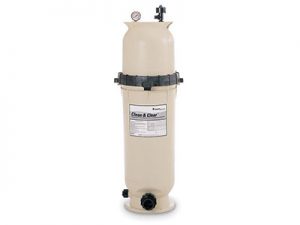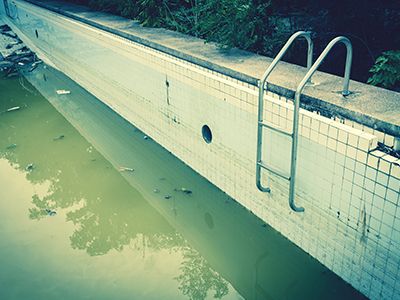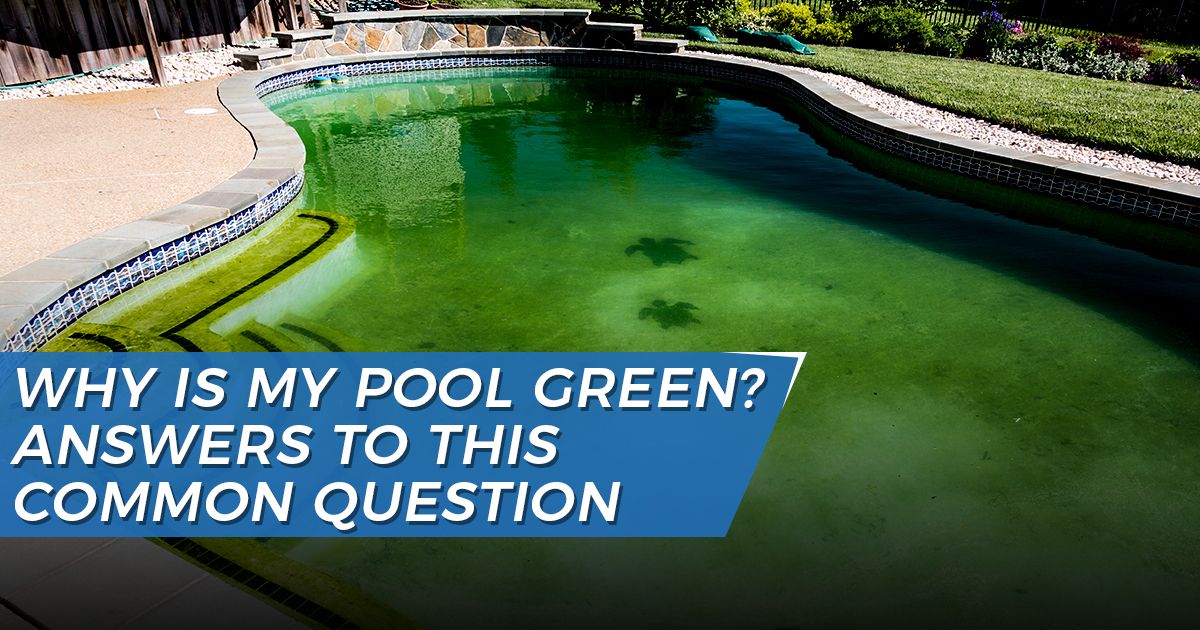Why Is My Pool Green? Answers To This Common Question
There is nothing worse than waking up in the morning and thinking, why is my pool green? But it’s a common occurrence and nothing you should be overly concerned about. It could be cloudy, filmy, or have patches of dark green, and still, it is fairly normal. Although green pool water is something most would consider somewhat normal, it’s good to know that it’s likely due to just one thing and easy enough to fix.
Related Article: How to Clean a Green Pool Fast
This Is Why You Have a Green Pool
The main reason for green pool water is that you have a growth of green algae. While debris like leaves and dirt could potentially be the culprit, they will likely not cause the green water that many owners worry most about. Green algae tend to appear when it’s very warm and sunny, and if there is a rich food source present. It can also be dropped into your pool by rain, clothes and shoes, the wind, and an overabundance of nitrates and phosphates. Green algae will spread fast, which is why you might notice the change in such a short amount of time.
There is no reason to panic, though. While there isn’t much that can be done to prevent the spores from being circulated, you can make sure it doesn’t continue to grow and spread.
Tips to Prevent You from saying Why Is My Pool Green
Circulation, treatment, and filtration are essential to keeping algae away and avoiding green pool water in the first place. Routine maintenance and cleaning ensure everything is working the way it should, and that if particles do find their way into your pool, you’re able to remove them before things get worse.
Check Your Filter and Balance Chemicals
As long as your filter is working properly you shouldn’t run into too many issues. A tint of green water after a long, heavy storm is typical, but if your filter is in great shape, it should be able to clear things out easily. If you think you’re in need of a new filter, consider this Pentair Clean and Clear filter for no-tool servicing and easier cleaning.

Additionally, green algae can develop when your chemical levels are too low. Check for a pH level of 7.2 or 7.6, and chlorine levels between 1 and 3. Any chlorine level under 1 ppm (parts per million) will allow algae to grow. Chlorine levels can drop when it is very sunny, as the chlorine burns under intense UV rays. Low chlorine levels may also be caused by too much cyanuric acid in the water.
Cyanuric acid is added to chlorine tablets to stabilize the chlorine. You should have some amount of cyanuric acid in your water at all times, as it makes chlorine more resistant to UV light. However, adding too much cyanuric acid will render the chlorine useless. And remember, low chlorine levels mean green algae growth.
Regular Maintenance Prevents Green Pool Water
Like cleaning your home, pool cleaning is necessary to keep things under control. The best way to prevent green algae from spreading is to keep it out in the first place. The easiest way to have a hands-on approach to cleaning is to skim your pool’s surface on a regular basis. We recommend doing this every other day at the least, but daily if it fits your schedule.
You should also maintain proper sanitizer levels. This means you’ll need to test your water and add sanitizer as necessary. There is also algaecide that can be used during regular maintenance for pools that might seem algae prone.
Regular pool maintenance might seem a bit daunting, which is why we’re here to help. It really isn’t as simple as removing leaves and branches, the right equipment and chemicals make sure the job is done properly. A professional cleaner can save you time and money, and leave you satisfied that everything is done correctly and efficiently. We can be in and out in under 30 minutes if you choose to leave the task to the professionals.
Related Article: How to Maintain a Swimming Pool: Getting the Chemistry Right
How To Fix Algae Growth and Green Pool Water
There are a few different colors of algae that are worth understanding a bit more. If you notice that your water is black, yellow, or even pink, consider reading our Pool Algae Series.
But if your pool water is light-green, dark green, or so dark that it could even be categorized as brown or black, it’s best to begin treatment.
Identify Which Type of Algae You’re Dealing With
Green algae are the most common type of algae, but it does vary in color a bit. It could be blue-green, yellow-green, or even dark green. It will either be free floating in the water or even cling to the walls. Green algae can be extremely intrusive and unpleasant. Their shape and biology even differ within the same division, Chlorophyta. However, they all respond to the same stimuli and thrive in the same environments.
Start to Fix the Problem
You can start fixing your green pool water by yourself. You’ll want to start by removing any and all debris, and then begin vacuuming. Remove as much algae as possible by vacuuming and then begin to brush. However, a simple tool brush might not be enough. There are specific algae brushes on the market, but if the job seems a little out of hand, consider bringing in the professionals before investing in more equipment.
Prepare for Shock Treatment
Before the main cleaning event, you’ll want to test your pH and chlorine levels. If you discover cyanuric acid levels are too high, you can simply dilute them with fresh water. If chlorine levels are too low, you will have to bring them back up again before you can start the treatment. Additionally, the filter and pump should be on for at least 10 hours before the treatment, and at least 10 hours after you’ve performed the treatment.
Shock the Green Algae Out Of Your Pool
 Once you’ve prepped, you can begin by adding the shock treatment. This involves adding a very high dose of chlorine. Consider combining the shock treatment with an anti-algae solution. Chlorine by itself may not be sufficient to kill off all of the algae. You may also want to add a flocculating agent. Flocculants help the dead algae clump together, making it easier to clean up.
Once you’ve prepped, you can begin by adding the shock treatment. This involves adding a very high dose of chlorine. Consider combining the shock treatment with an anti-algae solution. Chlorine by itself may not be sufficient to kill off all of the algae. You may also want to add a flocculating agent. Flocculants help the dead algae clump together, making it easier to clean up.
Always plan to shock twice, but for deeper greens, you may want to shock up to four times.
Leave your water filter on after performing the treatment. Check your filter a few times each day, to ensure no debris is blocking it. Your water should start clearing up after a day or so, but if it seems like things are not improving, it’s time to call in the professionals.
Related Article: Pool Shock Guide: What it is and How to Use it
Your Why is My Pool Green Specialists
If you’re still asking, why is my pool green? after a few days, it’s best to call in a specialist. The issue could be more complex than you thought and you may end up wasting more money trying to fix it yourself. We provide comprehensive pool cleaning and maintenance services and our technicians will perform every step from determining the cause to providing cost-effective solutions. Contact us today at one of our locations in New Tampa, Land O’Lakes, or Lutz where we have been serving customers in Wesley Chapel, Pebble Creek, Tampa Palms, Odessa, Seven Springs, Lake Fern, and others, for over 20 years.

